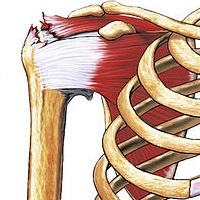
Photo from wikipedia
BACKGROUND Several short-stemmed press-fit humeral components have been developed in recent years for anatomic total shoulder arthroplasty (TSA) as well as reverse shoulder arthroplasty (RSA). Varying radiographic outcomes have been… Click to show full abstract
BACKGROUND Several short-stemmed press-fit humeral components have been developed in recent years for anatomic total shoulder arthroplasty (TSA) as well as reverse shoulder arthroplasty (RSA). Varying radiographic outcomes have been reported, with some studies reporting concerning rates of aseptic loosening. This study analyzed the radiographic findings of a press-fit convertible short-stemmed humeral component in both TSA and RSA. METHODS There were 150 anatomic TSAs (group 1) and 77 RSAs (group 2) analyzed radiographically at a minimum follow-up of 2 years postoperatively. Plain radiographs were reviewed for stem loosening, alignment, signs of stress shielding, and the filling ratio. RESULTS At final follow-up, 49% of group 1 and 65% of group 2 had no evidence for radiographic changes. In those with radiographic changes, low bone adaptions were found in 83% and high adaptions in 17% in both groups. Larger stem sizes with higher filling ratios were associated with high radiographic adaptions in both groups (P = .02). The overall filling ratios were higher in group 2 (P = .002). Cortical contact of the stem led to higher bone adaptions (P = .014). CONCLUSIONS The short humeral component analyzed in this study showed encouraging survival rates without aseptic loosening. Radiographic changes are associated with a higher filling ratio and cortical contact of the stem. Surgeons should aim to achieve fixation with the minimal required canal filling to minimize radiographic changes with the uncemented humeral component used in this study.
Journal Title: Journal of shoulder and elbow surgery
Year Published: 2019
Link to full text (if available)
Share on Social Media: Sign Up to like & get
recommendations!